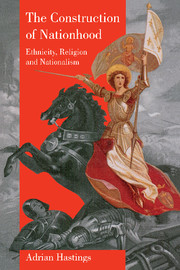7 - Ethnicity further considered
Published online by Cambridge University Press: 05 June 2012
Summary
Our pursuit of the rise of nations, national consciousness and nationalism in medieval and early modern Europe, as well as in Africa, has led back time and again to pre-existent ethnicities out of which nations have been wholly or partially constructed. But what really do we mean by ethnicities, in what did they consist, why did they exist, and how durable were they? It is currently fashionable to be sceptical about their very existence, but, in point of fact, as John Lonsdale insists, ‘ethnicity is a world-wide social fact’. The point at which to start is that of observable character, not that of origin, whether claimed or hypothesised.
By ethnicity, I mean the common culture whereby a group of people share the basics of life – their cloth and clothes, the style of houses, the way they relate to domestic animals and to agricultural land, the essential work which shapes the functioning of a society and how roles are divided between men and women, the way hunting is organised, how murder and robbery are handled, the way defence is organised against threatening intruders, the way property and authority are handed on, the rituals of birth, marriage and death, the customs of courtship, the proverbs, songs, lullabies, shared history and myths, the beliefs in what follows death and in God, gods or other spirits.
- Type
- Chapter
- Information
- The Construction of NationhoodEthnicity, Religion and Nationalism, pp. 167 - 184Publisher: Cambridge University PressPrint publication year: 1997



